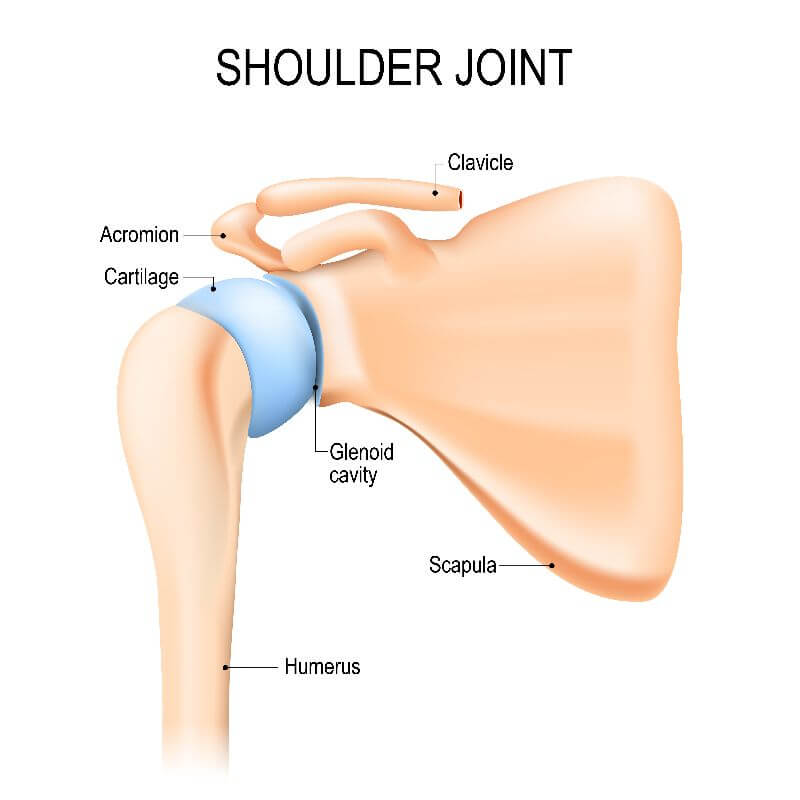Frozen shoulder, also called adhesive capsulitis, is a condition that causes severe pain and stiffness in the shoulder. It most commonly affects people between the ages of 40 and 60, occurring more often in women than in men. Over time, the shoulder becomes stiffer and stiffer, making it difficult to move.
The shoulder is a “ball and socket” joint, with the ball-shaped head of the humerus (upper arm bone) fitting into a socket called the glenoid. The glenoid is shallow and is the lateral part of the scapula (shoulder blade). The rotator cuff is a group of four muscles and tendons that helps with lifting and rotating the arm. It also helps to stabilize the shoulder and facilitate shoulder movement.
The ball is held in the socket by ligaments and by the rotator cuff tendons. Synovial fluid lubricates the shoulder capsule and the joint to help your shoulder move more easily.
The shoulder capsule is the collective name for all of the ligaments that surround the shoulder joint. The capsule provides stability for the shoulder while allowing for an incredible range of motion of the shoulder joint.
As frozen shoulder develops, the shoulder capsule thickens and becomes stiff and tight. Stiff bands of tissue (adhesions) form, and in many cases, there is less synovial fluid in the joint. The hallmark sign of a frozen shoulder is stiffness that does not respond to stretching.
There are three stages of frozen shoulder:
Stage 1 - Freezing Stage. In the freezing stage, you slowly have more and more pain. As the pain worsens, the loss of range of motion increases. Freezing usually lasts from 6 weeks to 9 months.
Stage 2 - Frozen Stage. In the frozen stage, your pain symptoms may improve, but the stiffness remains. This stage typically lasts 4 to 6 months, and during this time, daily activities may be quite difficult.
Stage 3 - Thawing Stage. Shoulder motion slowly improves in the thawing stage. Return to normal or close to normal motion and comfort typically takes anywhere from 6 months to 2 years.
The causes of frozen shoulder are not well understood. There is no apparent connection to arm dominance or occupation. A few factors, such as the following, may put you more at risk for developing a frozen shoulder:
Diabetes. Frozen shoulder occurs much more often in people with diabetes, affecting 10 to 20 percent of these individuals. The reason for this is not known.
Other diseases. Some additional medical problems associated with frozen shoulder include hypothyroidism, hyperthyroidism, Parkinson's disease, and cardiac disease.
Immobilization. Frozen shoulder can develop after a shoulder has been immobilized for a period of time due to surgery, a fracture, or another injury. Having patients move their shoulders soon after injury or surgery is prescribed to prevent frozen shoulders.
The symptoms associated with frozen shoulder include:
- Dull or aching pain with shoulder or arm motion
- Pain located over the outer shoulder area and sometimes the upper arm
- Limited range of motion
- Shoulder stiffness and tightness
- Limited shoulder function and strength secondary to pain
During your consultation, your doctor will ask you questions about your medical history and shoulder symptoms. He will also examine your shoulder and move it carefully in different directions to see if movement is limited and if pain occurs with the motion. He’ll check if you have a limited range of motion both actively and passively, which is the hallmark finding of a frozen shoulder. Active range of motion refers to you moving your shoulder on your own, and passive range of motion refers to your doctor moving your shoulder for you.
Additionally, your doctor may order imaging tests to help rule out other causes of stiffness and pain in your shoulder. These tests may include:
- X-Ray. X-rays show clear images of dense structures such as bone and may show other causes of a limited range of motion in your shoulder, such as arthritis.
- MRI and Ultrasound. These studies provide clear images of soft tissues and may identify other problems in the shoulder, such as a torn rotator cuff.
Frozen shoulder generally resolves over time, although it may take up to 3 years. Treatment focuses on controlling pain and restoring motion and strength through gentle exercises or physical therapy.
More than 95 percent of patients improve with time and simple treatments to help control pain and restore motion.
Non-steroidal anti-inflammatory medication. Drugs like Motrin, Aleve, and Ibuprofen help reduce pain and swelling.
Heat. A heating pad or warm shower generally helps to reduce the pain associated with a frozen shoulder.
Steroid injection. Cortisone is a powerful anti-inflammatory medicine injected directly into your shoulder joint to help relieve the pain caused by a frozen shoulder. Your doctor will discuss if this treatment is a good option for you.
Gentle exercises/physical therapy. These may be a home exercise program or exercises performed under the supervision of a physical therapist. Heat may be used to help loosen the shoulder up before the stretching exercises.
Surgical treatment of a frozen shoulder is rarely necessary, but if your symptoms persist despite time and adequate nonsurgical treatment, your doctor may discuss surgery with you. The goal of surgery for a frozen shoulder is to release the stiffened joint capsule to regain a permanent full range of motion of the shoulder.
Shoulder Arthroscopy: Capsular Release with Manipulation. During this procedure, the orthopedic surgeon cuts through tight portions of the joint capsule using pencil-sized instruments inserted through small incisions around your shoulder. This allows precise cutting without risking injury to the surrounding structures. Following the cutting of the tight portions of the joint capsule, a gentle manipulation maneuver is performed to release the tightening completely and increase the range of motion. Intensive physical therapy following the procedure is required to maintain the increased range of motion gained during surgery. Most patients have very good outcomes with this procedure.
Physical therapy after surgery is necessary to maintain the motion that was achieved with surgery. Recovery time can vary from 6 weeks to 3 months. Commitment to daily range of motion exercises after surgery is the most important factor in achieving an optimal outcome.
Long-term outcomes after surgery are generally good, with most patients having reduced or no pain and greatly improved range of motion. In some cases, however, the motion does not return completely, and a small amount of stiffness remains even after several years.
Although uncommon, frozen shoulder can recur, especially if a contributing factor like diabetes is still present. The risk for someone with a frozen shoulder eventually developing a frozen shoulder in the other shoulder is approximately 35 percent.
If you would like to schedule a consultation for a frozen shoulder evaluation with one of our orthopedic surgeons at OrthoMed, please call
(209) 524-4438. You may also
request an appointment online.




